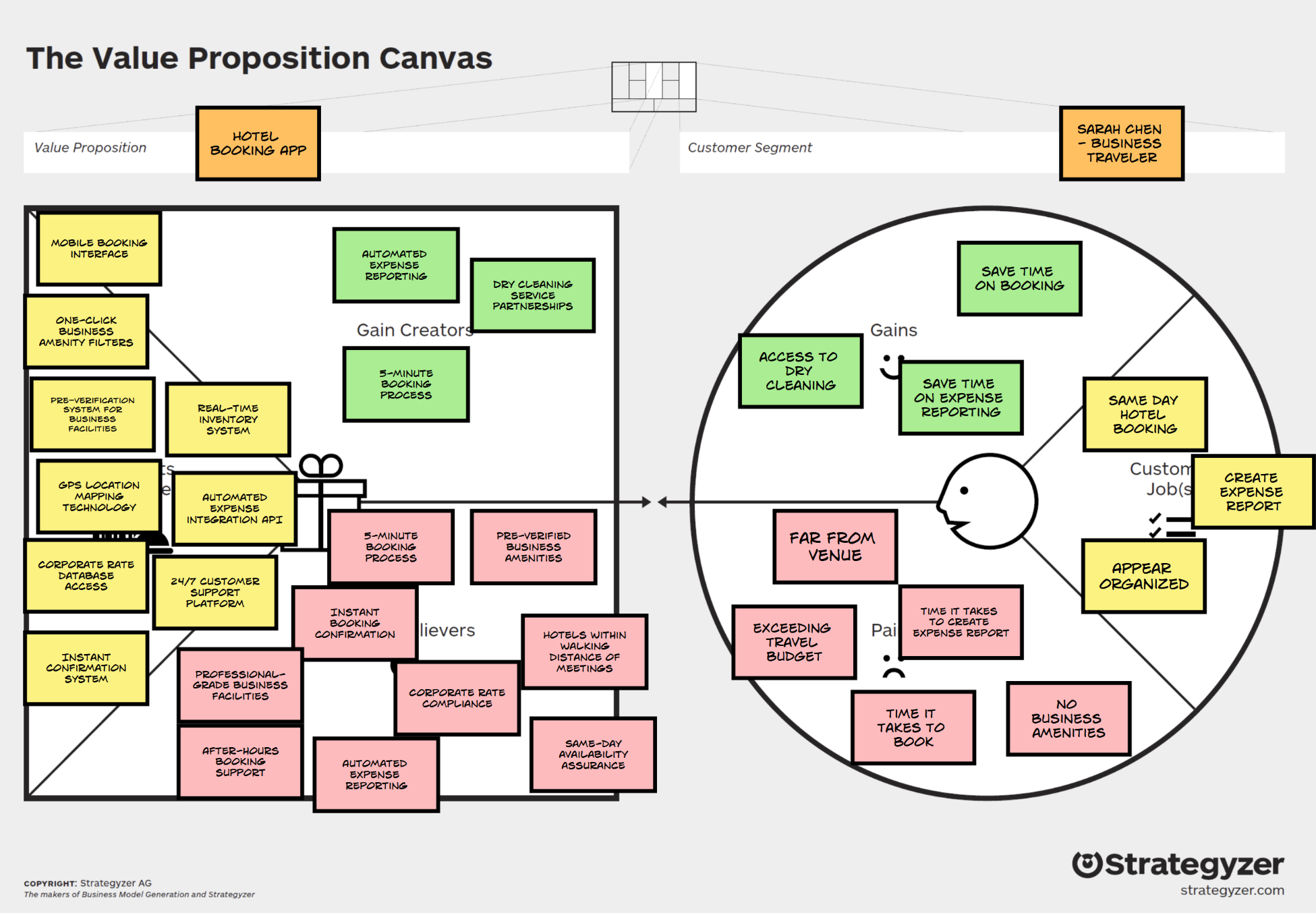Many new products fail because they solve problems customers don’t have or don’t care about. The Value Proposition Canvas ensures you build what customers actually need. It is a strategic tool that helps companies transform customer insights into successful products by creating perfect alignment between customer needs and product offerings.
What Is the Value Proposition Canvas?
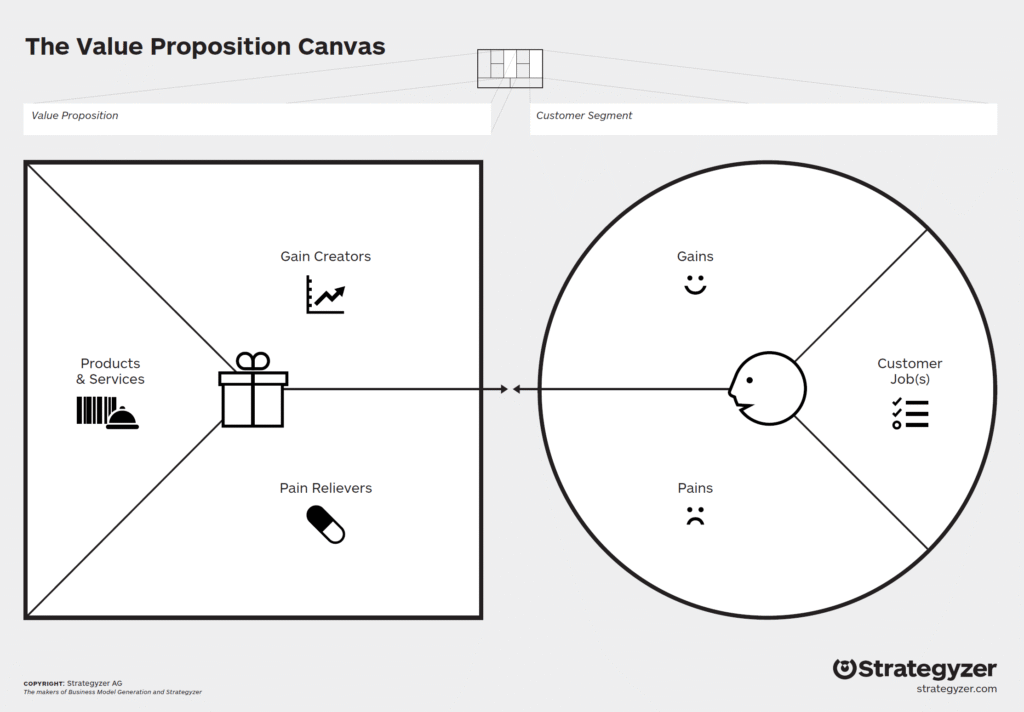
The Value Proposition Canvas is a strategic design framework that maps how your products create genuine value for customers. Developed by Alexander Osterwalder and the Strategyzer team, this tool provides a systematic approach to understanding the critical relationship between customer needs and your solution.
The canvas consists of two interconnected components:
- Customer Profile (right side): Deep understanding of your customer’s world
- Value Map (left side): How your product fits into that world
Success happens when these sides achieve “fit” where your value proposition directly addresses your customer’s most important jobs, pains, and gains. The Value Proposition Canvas builds upon and extends the Jobs to Be Done framework by incorporating the core concept of customer “jobs” while adding structured analysis of pains and gains, plus a direct connection to value proposition design through Pain Relievers and Gain Creators.
The Customer Profile: Understanding Customer Jobs, Pains, and Gains
Before creating value, you must understand what customers truly need. The Customer Profile reveals this through three dimensions that drive every purchase decision: Jobs, pains, and gains.
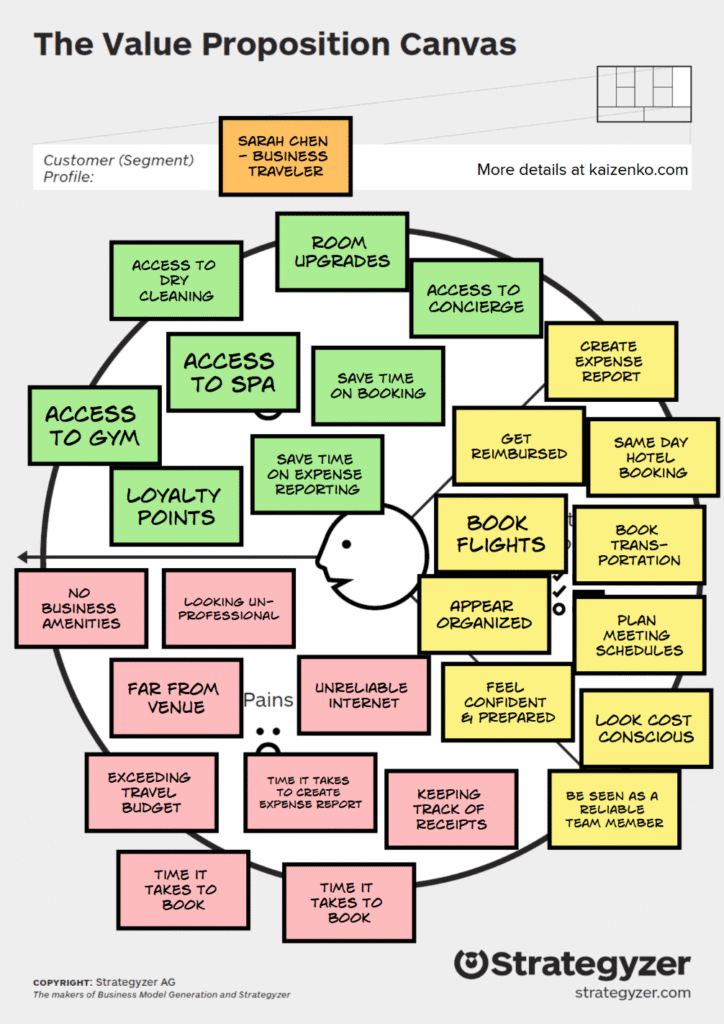
Customer Jobs to Be Done
Jobs represent the tasks customers try to accomplish in their work or personal life. Understanding these jobs forms the foundation of product-market fit. To see how this works in practice, let’s examine Sarah Chen, a marketing director who frequently books business travel.
Functional Jobs: Practical tasks requiring completion
- Book hotel rooms for same-day business trips
- Book flights and transportation to business destinations
- Plan meeting schedules and logistics around travel
- Create expense reports for business travel
- Get approval for travel expenses from management
Emotional Jobs: Feelings customers want to experience or avoid
- Feel confident and professional when hosting important clients
- Feel prepared and organized across all business travel tasks
- Feel calm and focused during business travel
- Feel confident about travel timing and logistics
- Feel energized and present with family despite travel schedules
- Feel in control of business logistics despite last-minute changes
- Feel balanced between work and personal life despite travel demands
Social Jobs: How customers want others to perceive them
- Appear organized and efficient to colleagues and management
- Look cost-conscious to finance teams while maintaining professional standards
- Demonstrate preparedness to clients regardless of travel complications
- Be seen as a reliable team member who travels efficiently
- Appear as someone who handles complex logistics effortlessly
Customer Pains
Pains are obstacles, frustrations, and risks that prevent job completion or create negative experiences. Think of undesired outcomes or results customers actively try to avoid, obstacles or barriers that slow things down or prevent them from getting started, and risks that have potential negative consequences with serious impact.
- Arriving at hotel without essential business amenities
- Booking accommodations too far from meeting locations
- Discovering unreliable internet connectivity during important calls
- Time-consuming booking processes requiring 30+ minutes
- Need to contact hotels individually to verify business facilities
- Complex expense systems requiring manual receipt entry
- Unclear booking confirmations that create uncertainty about reservations
- Unpredictable travel delays that disrupt carefully planned schedules
- Missing client meetings due to poor hotel location
- Exceeding company travel budgets and facing management scrutiny
- Looking unprofessional due to accommodation-related problems
Customer Gains
Gains represent benefits and positive outcomes that customers seek from solutions. Thinks of basic expectations without which solutions fail, standard benefits customers anticipate, benefits that would delight customers beyond basic or standard expectations, and surprising benefits that customers wouldn’t expect.
- Time savings on hotel booking tasks
- Time savings on expense reporting
- Access to gym facilities during travel
- Loyalty points and miles for future travel
- Enhanced room and service quality through upgrades
- Access to spa services for relaxation
- Professional appearance maintenance through dry cleaning
- Personalized concierge assistance
- Local knowledge through city guides
- Quality dining recommendations
Prioritizing Customer Needs for Value Creation
Now that we understand Sarah’s complete business travel context, we must make strategic choices about which jobs, pains, and gains our hotel booking service should address. Remember, the best value propositions focus on resolving only the highest priority customer needs rather than trying to satisfy everything. Let’s say we identify Sarah’s priorities as:
Sarah’s Priority Jobs:
- Book hotel rooms for same-day business trips (core job, highest urgency)
- Create expense reports for business travel (required corporate compliance)
- Appear organized and efficient to colleagues and management
Sarah’s Priority Pains:
- Time-consuming booking processes requiring 30+ minutes
- Time-consuming expense report process
- Risk of booking hotels too far from meeting locations
- Risk of arriving at hotels without essential business amenities
- Risk of exceeding company travel budgets
Sarah’s Priority Gains:
- Time savings on hotel booking tasks (required gain)
- Time savings on expense reporting (expected gain)
- Professional appearance maintenance through dry cleaning (essential for business success)
This prioritization allows us to design a focused value proposition that excels at solving Sarah’s most critical hotel-related needs while acknowledging her broader business travel context.
The Value Map: Designing Customer-Centric Solutions
The Value Map translates customer understanding into specific product design decisions that create genuine value. Understanding the distinction between these three components is crucial for effective value proposition design.
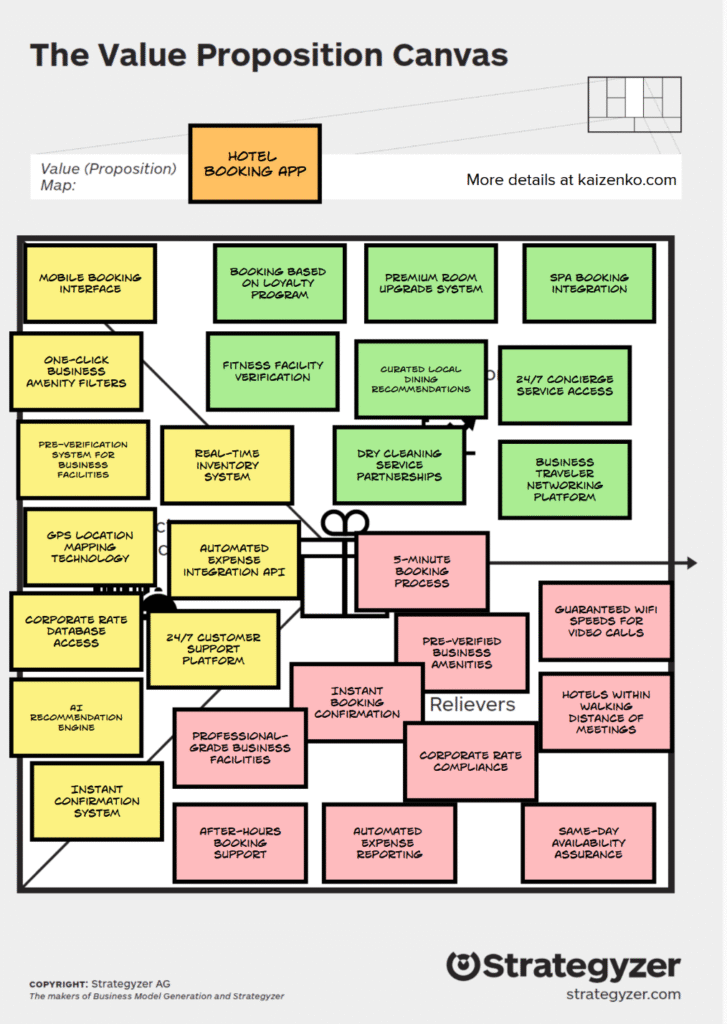
Products and Services
List specific features, functionalities, and characteristics your offering provides. Avoid vague benefits and focus on concrete deliverables.
Sarah’s business travel example:
- One-click business amenity filters
- Mobile booking interface
- Real-time inventory system
- Pre-verification system for business facilities
- GPS location mapping technology
- Automated expense integration API
- Corporate rate database access
- AI recommendation engine
- 24/7 customer support platform
- Instant confirmation system
Pain Relievers
Describe how your products eliminate, reduce, or make customer pains more manageable.
For Sarah’s business travel example:
- 5-minute booking process
- Pre-verified business amenities
- Guaranteed Wi-Fi speeds for video calls
- Instant booking confirmation
- Corporate rate compliance
- Hotels within walking distance of meetings
- Automated expense reporting
- Professional-grade business facilities
- Same-day availability assurance
- After-hours booking support
Gain Creators
Explain how your products produce, maximize, or create new customer gains.
For Sarah’s business travel example:
- Automatic loyalty program enrollment
- Premium room upgrade system
- Spa booking integration
- Fitness facility verification
- Curated local dining recommendations
- 24/7 concierge service access
- Dry cleaning service partnerships
- Business traveler networking platform
Creating your value map is only half the challenge. The critical question becomes: Does your value map actually fit with your customer profile? And more importantly, does it focus on the priority items?
Achieving Value Proposition Fit
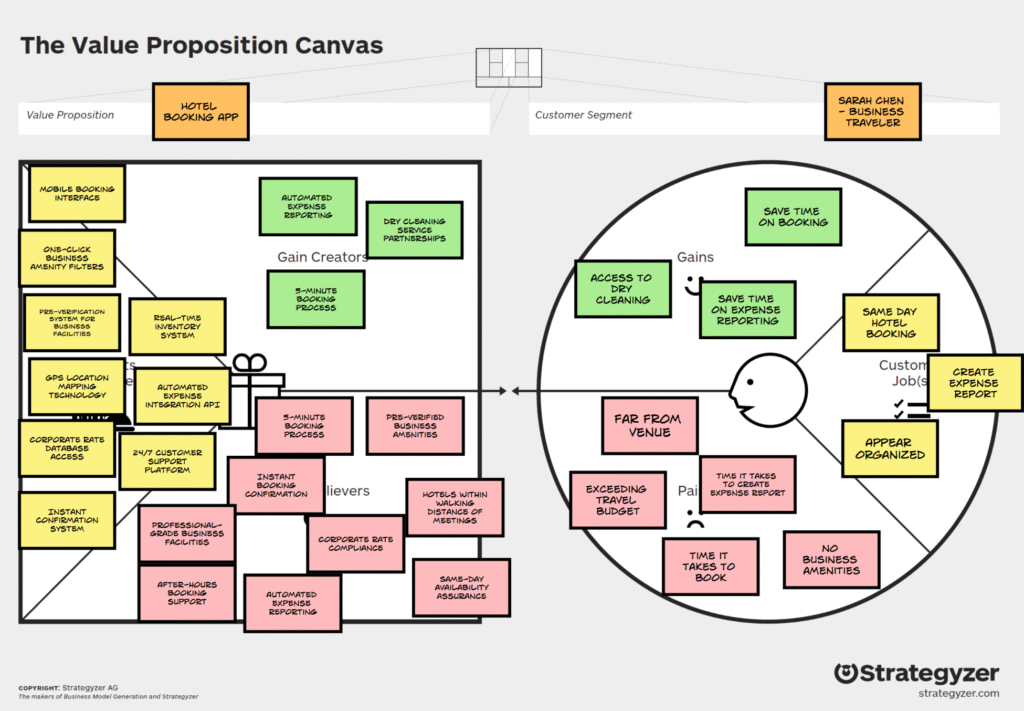
The ultimate goal is achieving “fit”, the degree to which your Value Map addresses the jobs, pains, and gains in your Customer Profile. This isn’t a binary state but rather a spectrum of alignment between what customers need and what you offer.
Value Proposition Fit occurs when your products, pain relievers, and gain creators directly address the most important jobs, pains, and gains in your Customer Profile. You have evidence that customers care about these elements and that your offering genuinely resolves them.
For Sarah’s business travel needs, we achieve Value Proposition Fit when our hotel booking solutions directly address her highest-priority jobs (booking hotels quickly for same-day travel, creating expense reports efficiently, maintaining professional preparedness), eliminate her most severe pains (time-consuming booking processes, verification obstacles, cumbersome expense reporting), and create her most desired gains (time saving, enhanced professional image).
The evidence might come from customer interviews showing business travelers struggle with these specific issues, prototype testing demonstrating our solutions reduce booking time by 80% while maintaining professional standards, and market validation where corporate travelers choose our service over alternatives because it addresses both their functional efficiency needs and their desired professional benefits.
While this guide presents value proposition design as a linear sequence for learning purposes, the actual process is highly iterative and non-linear. In practice, you’ll constantly move back and forth between understanding customers and designing solutions. Customer interviews might force you to redesign your value map. Prototype testing might reveal new customer insights that change your priorities. Market feedback might send you back to better understand jobs, pains, and gains. This continuous cycling between customer discovery and solution design is not a sign of poor planning, but is essential for achieving a genuine value proposition fit. You can think of fit at 3 different levels:
The Three Types of Fit:
- Problem-Solution Fit (On Paper): Customer interviews confirm they care about the jobs, pains, and gains you’re addressing
- Product-Market Fit (In the Market): Testing and market evidence show your solutions actually resolve customer needs and gain traction
- Business Model Fit (In the Bank): You can deliver your value proposition profitably and at scale
The stronger your Value Proposition Fit, the more likely customers will “hire” your solution to complete their jobs, relieve their pains, and achieve their gains.
Understanding fit is essential, but achieving it requires avoiding common pitfalls that derail even well-intentioned value proposition efforts.
Common Value Proposition Canvas Mistakes
Based on extensive field research by Strategyzer, here are the five most critical mistakes teams make when using the Value Proposition Canvas:
1. Not Seeing the Canvas as Two Separate Building Blocks: Many people struggle to distinguish between jobs, pains, and gains versus pains and pain relievers or gains and gain creators. The Customer Profile (circle) contains only things you can observe about customers that are outside your control. The Value Map (square) contains things you design into your value proposition that are within your control.
2. Mixing Several Customer Segments into One Canvas: Teams often group jobs, pains, and gains of multiple customer segments into one Customer Profile. This makes it impossible to know which segment’s needs you’re addressing and prevents you from designing compelling, focused value propositions. Create separate canvases for each distinct customer segment.
3. Creating Your Customer Profile Through the Lens of Your Value Proposition: Teams immediately start listing only the jobs, pains, and gains they see their solution resolving, failing to identify what customers really need. Step into your customers’ shoes like an anthropologist and forget what you’re offering. Use the “Five Whys” approach to identify deeper motivations.
4. Only Focusing on Functional Jobs: Most teams identify primarily functional jobs because they’re most visible. Push beyond obvious functional jobs to understand social and emotional jobs that drive customers. Social and emotional pains are often more deeply felt, and gains are more ferociously sought after.
5. Trying to Address Every Customer Pain and Gain: It’s unrealistic to satisfy everything for customers. Trying to do so results in unfocused efforts that don’t excel at anything, leaving customers unsatisfied. The best value propositions focus primarily on resolving only the highest priority jobs, pains, and gains for customers.
The Strategic Power of the Value Proposition Canvas
When used properly, the Value Proposition Canvas becomes a strategic compass that guides product development, marketing messaging, and business model decisions. Companies using this approach report higher success rates in new product launches, clearer customer communication, and better team alignment.
The canvas forces you to answer the most fundamental question in business: “Why should customers care?” When you can answer that question with evidence and specificity, you’re creating genuine value that customers will pay for, use, and recommend to others.
Taking Your Value Proposition Skills Further
For teams looking to deepen their customer-centric product development skills, including hands-on practice with the Value Proposition Canvas alongside other essential frameworks, the Building Innovative Products Workshop provides comprehensive training in customer research, product discovery, and strategic product management.
For a broader strategic perspective, the Business Model Canvas Workshop includes Value Proposition Canvas development and explores how it fits within your complete business model, covering revenue streams, key partnerships, cost structure, and other critical business components that bring your value proposition to life.
Product owners specifically can advance their skills through the Advanced Certified Scrum Product Owner (A-CSPO) certification, which includes building customer profiles alongside advanced customer research techniques, stakeholder management, and agile product strategy methods.
Resources for Further Learning
Value Proposition Canvas Tools:
- Strategyzer – Official home of the Value Proposition Canvas and Business Model Canvas by Alexander Osterwalder
Complementary Product Development Frameworks:
- Value Proposition Canvas Customer Profile Strategy – See how focus drives product success
- How to Create Personas That Drive Product Decisions – Learn to build research-based customer personas using the Persona Canvas
- Jobs to Be Done Framework: The Product Manager’s Guide – Discover customer motivations and switching triggers that drive product success
Professional Development:
- Building Innovative Products Workshop – Four-day immersive training covering Value Proposition Canvas, customer research, and product strategy
- Business Model Canvas Workshop – Deep dive into complete business model design including value propositions and revenue models
- Advanced Certified Scrum Product Owner (A-CSPO) – Advanced certification covering Customer Profile Map development alongside customer research and stakeholder management
The Value Proposition Canvas transforms how you think about customers and products. Use it to build solutions people actually want, and watch your product success rates climb while your customers become your strongest advocates.
Frequently Asked Questions About Value Proposition Canvas
Can I use the Value Proposition Canvas for existing products?
Yes. Many teams use the canvas to understand why current products succeed or struggle, then improve based on insights.
How many customer segments should I address?
Start with one primary segment. Master that before expanding to additional segments with separate canvases.
What’s the difference between Value Proposition Canvas and Business Model Canvas?
The Value Proposition Canvas focuses specifically on customer-solution fit. The Business Model Canvas covers the complete business model including partnerships, costs, and revenue streams.
How does the Value Proposition Canvas Customer Profile differ from user personas?
The Customer Profile focuses on jobs, pains, and gains that your product could potentially address, using a structured three-part framework. User personas include broader demographic and psychographic information like personality traits, communication preferences, and lifestyle details. The Customer Profile is designed specifically for value proposition development, while personas provide wider customer context for design and marketing decisions.
What’s the difference between Value Proposition Canvas Customer Profile and Jobs to Be Done framework?
Both focus on customer jobs, but JTBD emphasizes the circumstances and triggers that cause customers to seek solutions, with deep focus on switching moments and competitive alternatives. The Customer Profile provides a structured template for jobs, pains, and gains that directly connect to your value proposition design. JTBD is primarily a research methodology for discovering jobs, while the Customer Profile is a design tool for organizing insights and connecting them to solutions.
